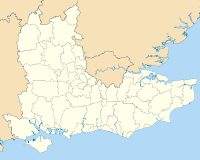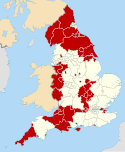User:Jaguar/draft/Portsmouth
Portsmouth
City of Portsmouth | |
|---|---|
| Nickname: Pompey | |
| Motto: Heaven's Light Our Guide | |
 Location within Hampshire | |
| Sovereign state | United Kingdom |
| Constituent country | England |
| Region | South East England |
| Ceremonial county | Hampshire |
| Admin HQ | Portsmouth City Centre |
| Government | |
| • Type | Unitary authority, City |
| • Governing body | Portsmouth City Council |
| • Leadership | Leader & Cabinet |
| Area | |
| 15.54 sq mi (40.25 km2) | |
| Population (2022) | |
| 208,420 (Ranked 76th) | |
| • Urban | 855,679 |
| • Metro | 1,547,000[1] |
| • Ethnicity (United Kingdom Census 2006 Estimate)[2] | 91.4% White 3.6% S.Asian 1.2% Black 1.3% Mixed 2.5% Chinese and other |
| Time zone | UTC0 (GMT) |
| • Summer (DST) | UTC+1 (BST) |
| Area code | 023 |
| Website | Portsmouth City Council |
Portsmouth (/ˈpɔːrtsməθ/ ⓘ) is the second largest city in the ceremonial county of Hampshire on the south coast of England. Located mainly on Portsea Island, it is the United Kingdom's only island city. Portsmouth is situated 64 miles (103 km) south west of London and 19 miles (31 km) south east of Southampton. The city has a population of 205,400 and is the only city in the United Kingdom with a greater population density than London.[3][4] The City of Portsmouth and Portsmouth Football Club are both nicknamed "Pompey".
As a significant naval port for centuries, Portsmouth has the world's oldest continuously used dry dock and is home to some famous ships, including HMS Warrior, the Tudor carrack Mary Rose and Lord Nelson's flagship, HMS Victory (the world's oldest naval ship still in commission). By the 19th century, Portsmouth was one of the most fortified cities in the world.[5] During the Second World War, the city served as a pivotal embarkation point for the D-Day landings and was also chosen as the headquarters for the Supreme Allied Commander, Dwight D. Eisenhower. The city was bombed extensively during what was known as the Portsmouth Blitz, which resulted in the deaths of 930 people. Although smaller than in its heyday, the naval base at HMNB Portsmouth remains largest dockyard for the Royal Navy and is home to two-thirds of the entire surface fleet.[6]
The waterfront area and Portsmouth Harbour is dominated by the Spinnaker Tower, a 560 feet (170 m) landmark which stands as the United Kingdom's eleventh tallest structure as well as the tallest outside London. The former HMS Vernon naval shore establishment has since been redeveloped as an area of retail outlets, restaurants, clubs and bars known as Gunwharf Quays. As well as the naval base, Portsmouth International Port is a commercial cruise ship and ferry port which serves international destinations for freight and passenger traffic. Portsmouth forms part of the South Hampshire built-up area which also covers Southampton, Havant, Waterlooville, Eastleigh, Fareham and Gosport. With approximately 860,000 residents, it is the 6th largest urban area in England and the largest in South East England, forming the centre of one of the United Kingdom's most populous metropolitan areas with a population in excess of one million.[1]
History
[edit]Early history
[edit]
The Roman Saxon fortress of Portus Adurni, about 4 miles (6.4 km) northwest of Portsmouth, now Portchester, was originally established in the late 3rd century, probably by Marcus Aurelius Carausius.[7] The earliest records of the city did not survive,[8] though the Anglo-Saxon Chronicle, dated to the late 9th century,[9] mentions that a man named Port and his two sons Bieda and Mægla arrived in Britain with two ships to the place which is now Portsmouth and slew a young British noble man in 501.[10] [11] "Portesmuða" is the Old English name for Portsmouth, which means "mouth of the Portus harbour".[12]
During the Norman Conquest of 1066, Portsmouth is believed to have been destroyed by Norman invaders.[12] There was no mention of Portsmouth in the Domesday Survey of 1086.[13] The modern town is traditionally believed to have been founded by Anglo-Norman merchant Jean de Gisors in 1180, when he started a settlement on the island of Portsea to serve as a shelter for ships. The town received a royal charter in 1184, which is documented in the Southwick Cartularies.[8][14] and a year later, Portsmouth's first Anglican chapel was built, dedicated to Thomas Becket. It was erected and run by Augustinian monks of Southwick Priory.[15]
Medieval
[edit]In 1194 King Richard I returned from being held captive in Austria,[16] and embarked at Portsmouth with a fleet of one hundred ships and an army.[17] On 2 May 1194, Richard I gave Portsmouth its first Royal Charter granting permission for the borough to hold a fifteen-day annual "Free Market Fair", weekly markets, and a local court to deal with minor matters. The borough was also exempted from paying the annual tax, with the result that the money could be used for local matters.[18] Richard I later went on to build a number of houses and a hall in Portsmouth. Richard himself granted the town the arms of Isaac Komnenos of Cyprus, whom he had defeated prior to his capture.[citation needed]
The town developed as a port for trading wool and grain in the 13th century.[14]
See also
[edit]- Ferrol—Spanish Armada (1588)
- HMNB Portsmouth
- Old Portsmouth
- Portsmouth and Southsea Synagogue
- Southsea
- List of twin towns and sister cities in the United Kingdom
References
[edit]- ^ a b "British urban pattern: population data" (PDF). ESPON project 1.4.3 Study on Urban Functions. European Union – European Spatial Planning Observation Network. March 2007. pp. 120–121. Retrieved 30 March 2015.
- ^ "Neighbourhood Statistics".
- ^ "Concentrated Population Information, Portsmouth News". Retrieved 29 March 2015.
- ^ "Portsmouth Census Summary, Hampshire County Council" (PDF). Retrieved 29 March 2015.
- ^ Pevsner, Nikolaus; LLoyd, David (1967). The Buildings of England Hampshire and the Isle of Wight. Penguin Books. p. 422. ISBN 0140710329.
- ^ "HMNB Portsmouth". Royal Navy. Retrieved 1 April 2015.
- ^ "Portchester with Roman settlements nearby". Castleuk.net. Retrieved 29 October 2015.
- ^ a b "Early history of Portsmouth". Portsmouth-guide.co.uk. Retrieved 29 October 2015.
- ^ Points 2013, p. 5.
- ^ Webb 1989, p. 16.
- ^ Whitelock 1996, p. 160.
- ^ a b "Royal Connections: City of Portsmouth". Royal Central. Retrieved 29 October 2015.
- ^ Cramer 1985, p. 23.
- ^ a b Tomlin & Hancock 2013, p. 233.
- ^ "St Thomas's Portsmouth Cathedral | Old Portsmouth". Welcometoportsmouth.co.uk. Retrieved 9 August 2011.
- ^ Norris 1924, p. 76.
- ^ Slight & Slight 1828, p. 206.
- ^ Quail, Sarah (1994). The Origins of Portsmouth and the First Charter. City of Portsmouth. pp. 14–18. ISBN 0-901559-92-X.
Sources
[edit]- Cramer, James (1985). The Book of Portsmouth. Barracuda. ISBN 978-0-86023-244-5.
- Norris, Herbert (1924). Medieval Costume and Fashion. Courier Corporation. ISBN 978-0-486-40486-8.
- Points, Guy (30 May 2013). The Combined Anglo-Saxon Chronicles. Guy Points. ISBN 978-0-9557679-6-8.
- Slight, Henry; Slight, Julian (1828). Chronicles of Portsmouth, by H. and J. Slight.
- Tomlin, Amanda; Hancock, Matthew (17 January 2013). The Rough Guide to Dorset, Hampshire & the Isle of Wight. Rough Guides Limited. ISBN 978-1-4093-6494-8.
- Webb, John (1989). The Spirit of Portsmouth: A History. Phillimore. ISBN 978-0-85033-617-7.
- Whitelock, Dorothy (1996). English Historical Documents, 500-1042. Psychology Press. ISBN 978-0-415-14366-0.
External links
[edit]50°49′N 1°05′W / 50.817°N 1.083°W



